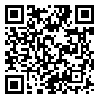1. Miller L. Juvenile crime and juvenilejustice: Patterns, models, and implications for clinical and legal practice. Aggress violent behav. 2014; 19: 122-37. [
DOI:10.1016/j.avb.2014.01.005]
2. Metis V, Luckman J. Oppositinal defiant disorder and conduct disorder in children: Arjomand publication; 2011.
3. Cullen FT, Wilcox P. Encyclopedia of criminological theory: Sage; 2010. [
DOI:10.4135/9781412959193]
4. Finkenauer C, Engels RC, Baumeister RF. Parenting behaviour and adolescent behavioural and emotional problems: The role of self-control. Int J Behav Dev. 2005; 29: 58-69. [
DOI:10.1080/01650250444000333]
5. Agino FT, Paternoster R, Cullen FT, Mackenzie DL. Life domains and crime: A test of Agnew's general theory of crime and delinquency. J Crim Justice. 2011; 39: 302-11. [
DOI:10.1016/j.jcrimjus.2011.03.006]
6. Soenens B, Vansteenkiste M,Luyckx K, Goossens L. Parenting andadolescent problem behavior: anintegrated model with adolescent self-disclosure and perceived parental knowledge as intervening variables. Dev psychol. 2006;42: 305. [
DOI:10.1037/0012-1649.42.2.305] [
PMID]
7. Ahmadi Kh, Khodadadi J, Amoosti F. An interactive model for parental monitoring and affiliation with delinquent peers on adolescents' aggression in military families. J Military Med. 2014; 16: 61-67.
8. Jones SE, Miller JD, Lynam DR. Personality, antisocial behavior, and aggression: A meta-analytic review. J Crim Justice. 2011; 39: 329-37. [
DOI:10.1016/j.jcrimjus.2011.03.004]
9. O'Riordan C, O'Connell M. Predicting adult involvement in crime: Personality measures are significant, socio-economic measures are not. Pers individ dif. 2014; 68: 98-101. [
DOI:10.1016/j.paid.2014.04.010]
10. Goldberg LR. An alternative "description of personality": the big-five factor structure. personality and personality disorders: Sci Mental Health. 2013; 7: 34.
11. Walters GD, DeLisi M. Antisocial cognition and crime continuity: Cognitive mediation of the past crime-future crime relationship. J Crim Justice. 2013; 41: 135-40. [
DOI:10.1016/j.jcrimjus.2012.12.004]
12. Garnefski N, Kraaij V, Spinhoven P. Negative life events, cognitive emotion regulation and emotional problems. Pers Individ dif. 2001; 30: 1311-27. [
DOI:10.1016/S0191-8869(00)00113-6]
13. WHO. Mental health: a state of well-being [updated 2014]. Available from: www.who.int.
14. Addley K. Mental health in the Northern Ireland Civil Service: studies on prevalence and determinants of mental ill-health: Queen's University of Belfast; 2000.
15. Razmkhah S, Pakzad B, Ahghar GH. The study of relationship between mental health and attitude to deliquencyin camp around city. J Psychol Res. 2013; 5: 539-48
16. Delavar A. Reasearch methodology in psychology and educative science Tehran: Virayesh publication; 2011. [in persian]
17. FathiAshtiani A. Psychological scales. Tehran: Besat Publication; 2001. [in persian]
18. Ghasempor A, El beygi R, Hasan Zadeh Sh. Psychometric properties of emotion regulation questionnaire grass and john among the Iranian population. Sixth Seminar mental health of students. 2012.
19. H Yaghubi MK, A Omidi, E Barouti, M Abedi. Validity and factor structure of the general healthe Questionnaire (GHQ 12) in university student. J Behav Sci. 2012; 6: 153-60.
20. Zadeh Mohammadi A AZ, Heidari M. Construction and assessment of psychometric features of Iranian adolescents risk-taking scale. Iranian J Psychiatry Clin Psychol. 2011; 17:218-25.
21. Snijders TA, Baerveldt C. A multilevel network study of the effects of delinquent behavior on friendship evolution. J Math Sociol. 2003; 27: 123-51. [
DOI:10.1080/00222500305892]
22. Alboukordi S, Nazari AM, Nouri R, Sangdeh JK. Predictive factors for juvenile delinquency: the role of family structure, parental monitoring and delinquent peers. Int J Criminol Sociol theory. 2012; 5: 770-7.
23. Taremian F Jazayery A, Ghazi Tabatabaei SM. Psychosocial predicting factors of drug use among adolescents: applicability of "Peer Group Theory" among Iranian Adolescents. J Zanjan Uni med sci. 2012; 21: 108-20.
24. Jolliffe D. Exploring the relationship between the five-factor model of personality, social factors and self-reported delinquency. Pers Individ Dif. 2013; 55: 47-52. [
DOI:10.1016/j.paid.2013.01.014]
25. Rahimi C, Abasi P, Keshtkar Gs. Prediction of different aggression component using the big five factor personality and gender in university student. J pers individ dif. 2015; 3: 49-72.
26. Magar EC, Phillips LH, Hosie JA. Self-regulation and risk-taking. Pers individ dif. 2008; 45: 153-9. [
DOI:10.1016/j.paid.2008.03.014]
27. Hoseinkhanzadeh. A. Taher M. Analytical study of personality characteristics of juvenile offenders. J crim justice. 2014: 31-53.
28. Fazel S, Wolf A, Chang Z, Larsson H, Goodwin GM, Lichtenstein P. Depression and violence: a Swedish population study. Lancet Psychiatry. 2015; 2: 224-32. [
DOI:10.1016/S2215-0366(14)00128-X]
29. Wood JJ, McLeod BD, Sigman M, Hwang WC, Chu BC. Parenting and childhood anxiety: Theory, empirical findings, and future directions. J Child Psychol Psychiatry. 2003; 44: 134-51. [
DOI:10.1111/1469-7610.00106] [
PMID]
30. Gibson C, Wright J. Low self-control and coworker delinquency: A research note. J Crim Justice. 2001; 29: 483-92. [
DOI:10.1016/S0047-2352(01)00111-8]
31. Eaton NR, Krueger RF, Johnson W, McGue M, Iacono WG. Parental monitoring, personality, and delinquency: Further support for a reconceptualization of monitoring. J Res Pers. 2009; 43: 49-59. [
DOI:10.1016/j.jrp.2008.10.006] [
PMID]
32. Hoeve M, Dubas JS, Eichelsheim VI,et al. The relationship between parenting and delinquency: A meta-analysis. J Abnorm Child Psychol. 2009; 37: 749-75. [
DOI:10.1007/s10802-009-9310-8] [
PMID] [
PMCID]
33. Patterson GR, DeBaryshe BD, Ramsey E. A developmental perspective on antisocial behavior: American Psychological Association; 1989. [
DOI:10.1037/0003-066X.44.2.329] [
PMID]
34. Lacourse E, Nagin D, Tremblay RE, Vitaro F, Claes M. Developmental trajectories of boys' delinquent group membership and facilitation of violent behaviors during adolescence. Dev Psychopathol. 2003; 15: 183-97. [
DOI:10.1017/S0954579403000105] [
PMID]
35. Hawkins JD, Herrenkohl TI, Farrington DP, et al. Predictors of youth violence. Juvenile Justice Bulletin. 2000. [
DOI:10.1037/e524202006-001]






